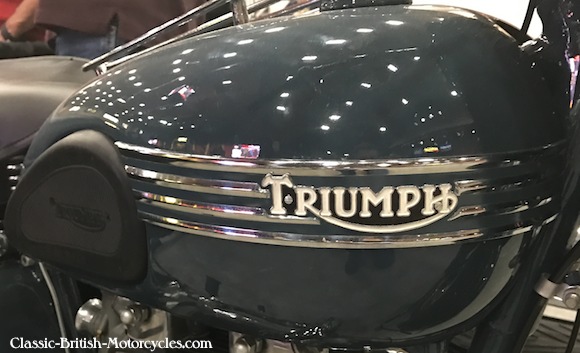1950 Triumph Thunderbird
1950 TRIUMPH THUNDERBIRD – BIRTH OF THE THUNDERBIRD
The 1950 Triumph Thunderbird was not only the first Thunderbird, it was the first Triumph 650 & it began a long legacy that lasted until the demise of Triumph Motorcycles in 1983. It is said that Edward Turner got the idea for the name from a motel he stayed in while visiting the US on business.
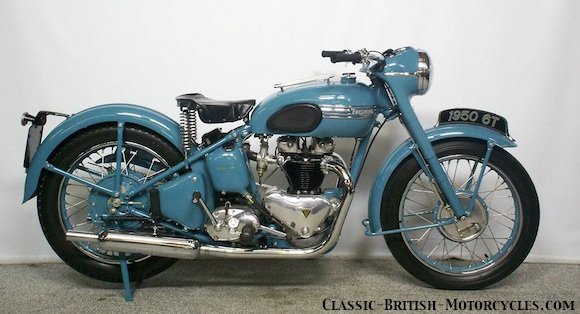
1950 TRIUMPH THUNDERBIRD – A STROKE OF GENIUS
He had another brilliant idea as well. As the quest for ever more power had pushed the 500cc Triumph Speed Twin to its limits, Turner simply expanded those limits. He bored it out to 71mm & stroked it out to 82mm & in doing so, created a 649cc fire-breather. The 6T Thunderbird was born & was instantly one of the fastest motorcycles on the market!
1950 TRIUMPH THUNDERBIRD – OLD IS MADE NEW
Another huge advantage was that most of the major engine castings remained relatively unchanged from the 500cc units already in production. And of course this meant that it all fit into the same frame as well, saving even more development & tooling costs. Just as he had done back in 1937 with the seminal Triumph Speed Twin, Edward Turner had once again created a game-changing motorcycle out of components already on the shelf.
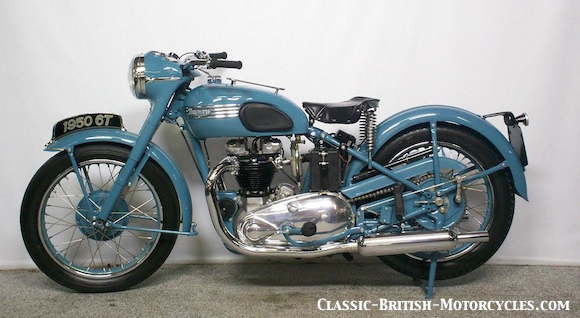
1950 TRIUMPH THUNDERBIRD – FRAME & RUNNING GEAR
These included the brazed-lug rigid frame, the rest of the running gear & the infamous “sprung hub”. This was another Edward Turner invention designed to bring some rear suspension travel (however slight) to the Triumph rigid frame without investing the money needed to replace it with a proper swing arm rear suspension. Essentially it placed springs radially between the rear axle & the hub/spokes/wheel. In theory, the springs would absorb the bumps while keeping everything in line. The problem should be obvious: any play in the system results in uncontrolled wheel movement & erratic handling. But, it remained in service until the swing arm came out in 1954.
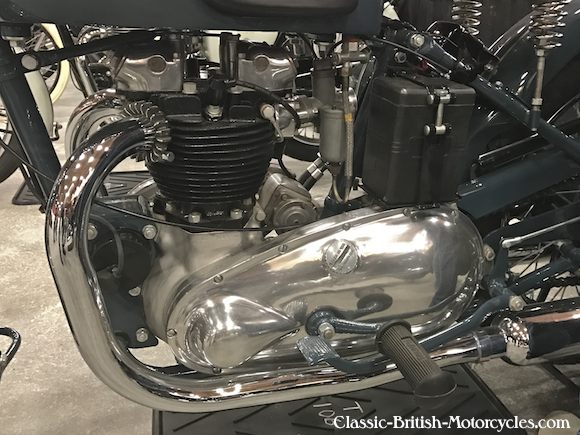
1950 TRIUMPH THUNDERBIRD – MORE STRENGTH
To cope with the added power, the 1950 Triumph Thunderbird got a new stronger 3-piece pressed-together crankshaft & the engine cases were beefed up around the main bearings. The oil pump’s capacity was increased by 20%. The gearbox was strengthened with larger pinions, a greater number of teeth (finer pitch) & improved shift forks. The clutch received an extra plate (now 5 drive & 6 driven).
1950 TRIUMPH THUNDERBIRD – GEAERING
Primary gearing was raised by replacing the Speed Twin’s 22-tooth engine sprocket with a 24-tooth. Changing the engine sprocket like this is actually the way the factory preferred to change gearing, as the final-drive sprocket remained 18-teeth on all twins up to & beyond unit construction in 1963.
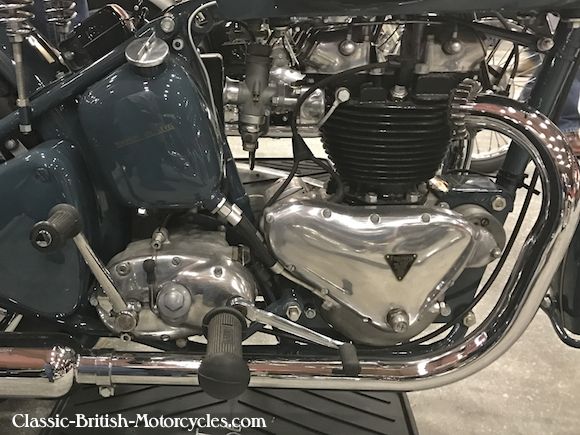
1950 THUNDERBIRD – OTHER CHANGES
Another interesting feature was the crankshaft shock absorber. Introduced with the 1950 T-Bird, it remained in service until the conversion to alternator electrics in 1953, which was now mounted in its place on the left end of the crank, inside the primary cover. This brilliant device decoupled the engine from the primary, linking them through a spring-loaded, cammed interface that allowed a controlled amount of ‘give’, smoothing out harmful vibrations. It is said to have made everything last longer: engines, primary chains, clutches, gearboxes & even final drive chains! When the alternator replaced it, Meriden attempted to do the same job with rubber shock absorbers inside the clutch hub, but it never worked nearly as well.
1950 TRIUMPH THUNDERBIRD – ENGINE
For the most part, the new Thunderbird 650 engine was the same as the 500cc Triumph Speed Twin it evolved from. The cast iron cylinder block & head were similar, but the 650 head was more generously finned & utilized a copper gasket instead of a ‘spigot’ arrangement, common for the day. The valve train was identical. Home market 650s had a 7:1 compression ratio to cope with the low octane British Pool fuels available at the time. However, export versions (read that US) had 8.5:1 which was enough to boost power to 34hp @ 6500 rpm, enough to push the 370lb Thunderbird past 100mph!
THE “T-BIRD LOOK”
The look of the Triumph Thunderbird was established early on & followed normal convention for a machine of its type. It had generous fenders, made to cope with wet British riding conditions, & a headlight nacelle housing not only the headlight, but the gauges, top yoke, fork tube tops & the center section of the handlebars. All of this weather protection was also supposed to make the bike easier to clean after riding in the rain. They sure were obsessed with riding in the rain, weren’t they? (Well, I guess we can’t all live in California.)
1950 TRIUMPH THUNDERBIRD – EDWARD TURNER HAD A GIFT
Edward Turner was not just a gifted mechanical engineer, he had a real talent for style & color. Just look what he did for the Triumph line when he arrived from Ariel Motorcycles in 1935. He sparked up sales & did it almost entirely by juicing up the colors on the bikes. For the Thunderbird, Turner selected a blue-grey called “Thunder-Blue”. It proved to be less than successful. The bike pictured here is actually a 1951 model 6T Thunderbird, as a suitable 1950 photo was not available. So the color is not correct for our study of the 1950 Triumph 6T Thunderbird. As mentioned, it should be Thunder-Blue (a blu-grey), but instead it is the correct color for 1951, Polychromatic Blue. Otherwise, the two model years are virtually identical.
1950 Triumph Thunderbird
SPECIFICATIONS
|
Engine type Displacement Bore & Stroke Compression Carburetor Ignition Engine output Primary drive Primary sprockets Clutch Gearbox Ratios, overall: 1st, bottom 2nd 3rd 4th, top Final drive Final drive sprockets Frame Type Suspension, front Suspension, rear Brake, front Brake, rear Tire, front Tire, rear Wheelbase Seat Height Ground Clearance Fuel capacity Dry weight |
Air-cooled OHV vertical twin, non-unit 649cc / 40.0 ci 71mm X 82mm / 2.79″ X 3.23″ 8.5:1 (US & export); 7.0:1 (UK) 1- Amal Monobloc, 1″ Lucas magneto 34 bhp @ 6500 rpm 1/2″ X .335″ X 5/16″ chain, 70 links 24T X 43T Multi-plate, wet 4-speed constant mesh, right foot shift
11.9:1 8.25:1 5.81:1 4.88 5/8″ X .400″ X 3/8″ chain, 101 links 18T X 46T Brazed lug, rigid Telescopic fork, hydraulic damping Sprung rear hub, rigid frame 7″ SLS drum 7″ SLS drum 3.25″ X 19″ 3.50″ X 19″ 55.25″ / 140.3 cm 31″ / 77.5 cm 5″ / 12.7 cm 3 Imp gal (US); 4 Imp gal (UK & export) 370 lbs / 168 kg |


